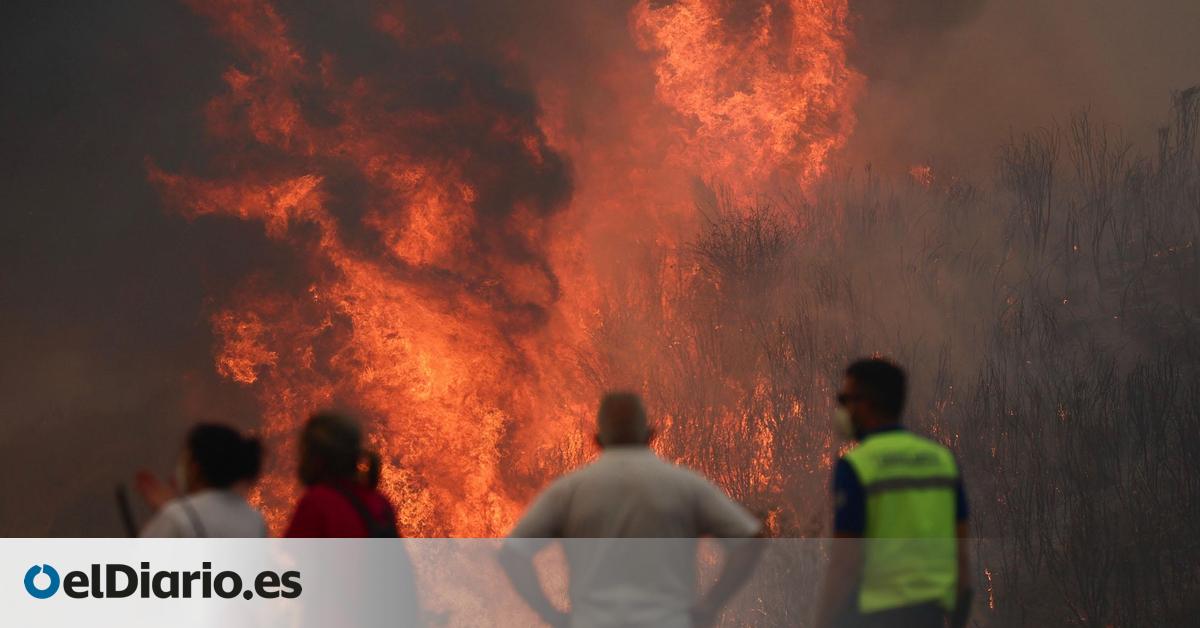
“There is a incendiary terrorism activity in Spain. 80% of the fires are intentionally.” The head of the PP, Alberto Núñez Feijóo, believes that there is a incendiary plot that is setting on fire to Spain. For Vox, Santiago Abascal, it is a conspiracy, also ideological: “The Spaniards always helpless in the face of climate terrorism, the Spaniards always without means and governments always with ideologies involved.”
But in the last five years, two out of three forest fires that are investigated – which are suspected that they do not have a natural cause, such as the fall of a ray – have their origin in a negligence or an accident. Only one in four was intentionally with the specific objective of seeing the mount burn for different reasons, according to data from the memory of the State Attorney General of 2024, a statistic that as little questions the theories of the rights with respect to the hatching of fires in the country. The Prosecutor’s Office does not explain in its memory which percentage of the total fires is investigated for being considered the result of human action (voluntary or involuntary), although several reports estimate that they are approximately 90%.
Those who are caused with the sole intention that Mount Arda, although minority, have concrete people and motivations behind, although sometimes it is difficult to locate some and determine the others. But it also happens and, in most occasions, they are quite prosaic: create pastures, harm someone, get a (normally economic) benefit, etc. Among the last acquaintances, in the Aliseda (Extremadura) the hunt was the motivation of the neighbor that, according to the Board, turned on a plot in two different points.
In the last two and a half months, the State Security Forces have arrested 41 people and investigate another 127 for starting fires, according to this Friday’s government. An always complicated work. “The forest fire is a criminal phenomenon with a high incidence and a very low police clarification rate,” writes Civil Guard Commander Andrés Sotoca in his thesis Criminological Profile of the Forest Four. Evidence -based empirical study2016.
The figures of these months, lower than those of other years, delve into the denial of conspiracy theory encouraged in networks and some media: in 2023 402 people were arrested for fires (33 per month); The previous year were 482 (40 every 30 days). This summer goes 41 in two and a half months.
Missing information
In addition, as experts and different organisms remember, a lot of information is missing regarding forest fires – Civio recalls that in three out of four fires the causality is supposed, not safe, among other issues because the fire itself destroys the evidence – and with respect to those who cause them, because formally it can only be classified as “incendiary” to whom it has a sentence, and these are not so numerous. “The fire investigation processes are slow,” explains Félix Pérez, president of the Association of Forest Agents of Galicia Aprafaga. “There is no probative value. Of a mecherazo in the mountain there are no evidence or vestiges. Many interviews, investigations, interrogations are made, but there is no crime weapon in the mountain and it is very complicated to throw back in time. You can have suspicions, but a suspicion does not take anyone to jail,” he recalls.
Leaving aside the phenomenon of arsonists (they are people affected by a mental disorder, as established by one of the few specific studies in this regard: “Pyromania is an exceptional condition and it is more likely that this type of authors have another type of psychological pathology”), experts explain that there is no unique set of the incendiary, although in general they share some common features, as observed from the detainees.
They are usually male, between young and medium -sized (even a minor was arrested in Santiago de Compostela a few days ago), with an objective beyond fire by fire, which can range from their own benefit to the foreign damage: burn some pastures, take revenge on a neighbor, a disagreement with the Board of Montes, scare animals …
Eight types
Almost 20 years ago Greenpeace conducted a study to try to find out who burns the mountain and why. The NGO established eight types of incendiary and its part of guilt:
- The “irresponsible farmer”, which with its periodic burning burn causes more than 31% of the fires and 13.9% of the burned surface.
- The “unconscious farmer”, which with its burning for pastures causes 21.5% of the fires and produces 26.5% of the burned surface.
- The “bad hunter”, which causes fires to favor certain hunting species, causing 2.1% of fires and 4.37% of the burned surface.
- The “reckless”, which with its bonfires and badly turned off plots cause 6.7% of the fires and 7.8% of the burned surface.
- The “Pytal”, an upset person without the intention of harming but causes 7.5% of the fires and 4.9% of the burned surface.
- The “conflicting associal”, a highly conflictive person, with problems of social integration and drug addiction that causes 3% of fires and 4.6% of the burned surface.
- The “interested”, citizens who seek to take advantage of the effects of forest fires for various reasons and that generate 0.6% of the fires, 0.3% of the burned surface
- “Important Don”, that from an office and with its decisions it causes, according to the calculations of the NGO, 2.6% of the fires and 6.7% of the burned surface.
In that 2007, these eight profiles represented 60% of the identified incendiary, were responsible for three out of four fires with known cause and burned 70% of the forest area each year in Spain.
In 2001, the Department of Análise do Servizo of Xudicial Police and the Unit of the Xudicial Police of Galicia area analyzed the profile of the people related to the fires. To do this, 667 people were studied, with special focus on 271 authors of intentional or doubtful mobile fires. From that report it came out that 249 were men and 22 women; 98% had Spanish nationality and committed the facts very close to their place of residence; 90% acted alone and 10% caused more than one fire.
The Civil Guard made a similar attempt with a sample of 530 charged and detained in the period 1998-2005. The conclusions of that study were similar to the previous one: 472 men and 58 women, all Spaniards except six, who acted with “geographical proximity with the place of residence”; Four out of five acted alone and 17% had a history; Their motivations went from grass regeneration to “unbalanced that enjoy the fire or the deployment of extinction means”, through disputes between neighbors or farm cleanings.
(Almost) always male
These days the news of the arrests of alleged fires and the profiles of the detainees and their motivations, when they transcend, seem to corroborate those theoretical frameworks.
This last Tuesday the Civil Guard arrested a 48 -year -old man for intentionally provoking a fire in Colmenar Viejo, in Madrid, on July 12. So far this year, six people have been arrested for a crime of forest fire in the Community of Madrid, who are the alleged responsible for almost twenty fires that went out this year in autonomy and that affected El Molar, Fresnedillas de la Oliva, El Escorial, Valdemorillo, San Martín de Valdeiglesias and Ciempozuelos.
In Galicia, the Civil Guard arrested a 47 -year -old man as the alleged author of the first great forest fire of summer in the Autonomous Community, which took place in Vilardevós, Orense, and burned more than 500 hectares. The man had a history of provoking fires and had been banished from his previous town.
A day earlier, the Civil Guard had arrested another 33 -year -old man as an alleged author of several fires around Badajoz. The male, who was surprised in fragantifaces an alleged crime against collective security committed through the intentional use of fire, by jeopardizing the lives and integrity of people, as well as the natural environment.
In Córdoba, in the last month at least two young people, from 19 and 23 years old, to another male of 46 and a fourth man have been arrested, the latter as alleged responsible for four fires.
Another different category is the negligence or accidents that are out of control. Examples of these can be found in Zamora, where the Civil Guard arrested a man as the alleged perpetrator of a reckless fire caused by an irregular deposit of waste and glass that turned on as a result of the magnifying glass, according to Europa Press.
Among the last cases recorded in this section are two detainees that caused a forest fire for lighting a bonfire during an camping. This fire was so little caused that one of them was injured trying to turn it off.
Another regular is the burns that seek to be controlled but on which control is lost. It has been the case of a investigated in El Bierzo, who will have to face an accusation for making use of fire to carry out herbaceous cleaning of herbaceous in a reckless and serious way, since, allegedly, he was burning stubble and that was the origin of the incident that ended up affecting 130 hectares of land.
The forest agent Pérez clears the idea of plots or conspiracies: “In fires there are causes (natural, accidental or intentional) and motivations. And for each fire there is a motivation.”
Source: www.eldiario.es

